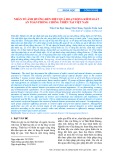
Modelling the effects of climate change on the distribution of benthic
indicator species in the Eastern Mediterranean Sea
Manos L. Moraitis
a,
⁎, Vasilis D. Valavanis
b
, Ioannis Karakassis
a
a
Marine Ecology Laboratory, Department of Biology, University of Crete, PO Box 2208, GR 70013 Heraklion, Greece
b
Hellenic Centre for Marine Research, Institute of Marine Biological Resources and Inland Waters, PO Box 2214, GR 71003, Heraklion, Greece
HIGHLIGHTS
•Climatechangeisexpectedtoaffectthe
distribution of benthic indicator species.
•The current ecological grouping is
irrelevant under the scope of climate
change.
•New perspective on the use of benthic
species as biotic tools
GRAPHICAL ABSTRACT
abstractarticle info
Article history:
Received 7 December 2018
Received in revised form 18 February 2019
Accepted 21 February 2019
Available online 24 February 2019
Editor: Daniel Wunderlin
The potential effects of climate change on the distribution of benthic species commonly used in marine ecological
quality assessment were investigated using a spatial modelling approach. In this work, the relevance of the eco-
logical groups that macrofaunal molluscs are assigned according to their sensitivity or tolerance to environmental
disturbance was examined under the scope of the RCP 8.5 severe emissions scenario. The effects of climate
change were more profound on species that are indicative of a specific suite of climatic conditions regarding tem-
perature and salinity. Significant loss of habitat suitability was observed for the tolerant species Corbula gibba and
Abra prismatica whereas the sensitive species Moerella donacina was least affected. In contrast, an overall expan-
sion of the distributional potential was observed for the sensitive species Flexopecten hyalinus as newly suitable
habitats are formed. As hypothesised, the current ecological grouping that depicts the sensitivity of a benthic spe-
cies to an environmental stressor is irrelevant when assessing the effects of climate change. We propose a new
standpoint of using benthic species as biotic tools based on their ecological niche requirements.
© 2019 Elsevier B.V. All rights reserved.
Keywords:
Benthos
Macrofauna
Climate change
Indicator species
Ecological groups
Species distribution modelling
1. Introduction
The Mediterranean Sea is often described as a “hot spot”for climate
change impacts (Giorgi, 2006) and it is expected to respond faster to
this pressure than the open ocean counterparts due to a unique
combination of hydrographic and geographical characteristics. More
specifically, its location between two different climatic regimes (the
arid climate of North Africa and the temperate climate of central
Europe) and limited hydrological exchange with the open ocean, render
the Mediterranean Sea more vulnerable to climatic alterations (Marbà
et al., 2015). Recent studies conclude that the Mediterranean Sea will
become warmer and more saline with varying consequences on the
region's primary production in the immediate future (Macias et al.,
2015;Piroddi et al., 2017). However, due to its semi-enclosed nature
Science of the Total Environment 667 (2019) 16–24
Abbreviations: SDM, species distribution modelling.
⁎Corresponding author.
E-mail address: manomort@icloud.com (M.L. Moraitis).
https://doi.org/10.1016/j.scitotenv.2019.02.338
0048-9697/© 2019 Elsevier B.V. All rights reserved.
Contents lists available at ScienceDirect
Science of the Total Environment
journal homepage: www.elsevier.com/locate/scitotenv

between two continents and its intricate orography, the Mediterranean
Sea is characterized by regions of highly contrasting physical and chem-
ical processes and the effects of climate change are expected to differ
across the basin. The east-west and north-south environmental gradi-
ents are modulated even more by regional differences in areas with
river outflow and complex topography (Basterretxea et al., 2018). One
of the main challenges regarding the assessment of the effects of climate
change in the Mediterranean region is the fact that not all areas are ex-
pected to be equally affected due to varying climatic conditions
(Lejeusne et al., 2010). According to Spalding et al. (2007), the Mediter-
ranean basin can be divided into further distinct provinces, two of
which are the Aegean and the Ionian Seas. The Aegean Sea is character-
ized by strong hydrological fronts of temperature, salinity and primary
productivity due to its geographic position between the Black Sea and
the Ionian and Levantine Seas (Giannakourou et al., 2014). Additionally,
the Ionian Sea is fronted by various water masses that depict a different
hydrographic pattern to the nearby Aegean province (Menna and
Poulain, 2009). Even though climate change impact on the Mediterra-
nean marine biota has been documented (Lejeusne et al., 2010), there
is a gap of knowledge on predicting the effects of climate change on
the distribution of marine species in such dynamic areas.
Soft-bottom macrobenthic species have been traditionally used as
biotic tools for assessing the ecological quality status of the Mediterra-
nean benthic ecosystems and have been proven useful proxies for eval-
uating the impact of various pressures in coastal and transitional aquatic
environments (Dauvin et al., 2017;de-la-Ossa-Carretero et al., 2012;
Moraitis et al., 2013). Their relatively sessile nature is a main attribute
that distinguishes macrofaunal species as environmental stress proxies
because they are unable to avoid deteriorating environmental condi-
tions (Sánchez-Moyano et al., 2017). Mollusca in particular is the most
sedentary group and due to their significantly wider range of tolerance
than the rest of macrofauna (Nerlovićet al., 2011;Pearson and
Rosenberg, 1978) are an ideal biotic tool for marine ecological status as-
sessment (Moraitis et al., 2018). The most relevant benthic biotic indi-
ces used in aquatic health assessment assign macrobenthic species
into different ecological groups according to their sensitivity or toler-
ance to a specific environmental stressor, mainly organic enrichment
with consequent low redox potential and hypoxia (Borja et al., 2000;
Dauvin and Ruellet, 2007;Rosenberg et al., 2004;Simboura and
Zenetos, 2002). Therefore, it is expected that species of the same ecolog-
ical group would respond with the same coping strategy in environ-
mentally disturbed habitats. This assumption has been proven in cases
regarding the impact of organic pollution (Dauvin and Ruellet, 2007).
However, it is unclear if the aforementioned species grouping is evident
under different climate change scenarios.
Speciesdistributionmodels(SDMs)areessentialtoolsforpredicting
the effects of climate change and marine global warming on species dis-
tributions. The incorporation of benthic molluscs in SDMs for assessing
the effects of different climate change scenarios is focused mainly on bi-
ological invaders (Jones et al., 2013;Raybaud et al., 2014;Sarà et al.,
2018), species of socioeconomic interest (Appelqvist et al., 2015;
Russell et al., 2012) and of high ecological value (i.e. important role in
ecosystem functioning) (Gormley et al., 2013) or a combination of the
aforementioned categories (Saeedi et al., 2017;Saupe et al., 2014). To
our knowledge, studies regarding the distribution of molluscan species
under climate change in the Mediterranean region are scarce (Sarà et al.,
2018) and not under the scope of re-examining the baselines of benthic
ecology that have been traditionally used for marine health assessment.
The aims of this study were to: i) predict the potential impact of the
extreme climate change scenario RCP 8.5 (worst-case scenario forecast-
ing the continuous increase of greenhouse gas emissions) on the distri-
bution of benthic molluscs commonly used in environmental impact
assessment for the year 2100; ii) evaluate the relevance of their current
ecological grouping according to the baselines of macrobenthic ecology
in response to climate change; and iii) examine the features that mark
the resistance or vulnerability of benthic species to climate change.
We assume that species indicative of a specific suite of environmental
conditions would respond to climate change according to their ecologi-
cal preferences regardless of their current ecological grouping. Future
climatic conditions are expected to greatly affect the distribution of
these indicative species compared to others occupying a broader eco-
logical niche. To our knowledge, no other study has addressed the po-
tential impacts of climate change on the distribution of benthic
organisms traditionally used in environmental disturbance assessment
in the Mediterranean basin using relevant modelling methods.
2. Materials and methods
2.1. Study design
The purpose of this study's sampling design was to capture the main
environmental gradients originating in the Aegean Sea (i.e. tempera-
ture, salinity, chl aconcentration) in order to incorporate the full ecolog-
ical response range of the benthic species that characterize this area. In
order to be more coherent and avoid bias in the findings of this study,
we also included sampling stations from the Ionian Sea (Fig. 1), a marine
region characterized by stable environmental conditions. This design is
based on Moraitis et al. (2018) and allows the full examination of the
benthic species responses under a specific environmental issue (in
this case climate change).
2.2. Biological data
In total, 123 soft-bottom macrofaunal samples were collected from
the Aegean and Ionian Seas (Fig. 1). The sampling took place between
April and July 2014, using a Smith-McIntyre grab with a sampling area
of 0.1 m
2
. After the collection, the macrofaunal samples were sieved
first over a 1 mm and then a 0.5 mm mesh sieve and fixed with 10% for-
malin. Before transfer to the laboratory for further analyses, the samples
were stained with Rose Bengal to facilitate sorting. In the laboratory,
samples were sorted and identified to species level. All species names
were checked for updates in their taxonomy through the World Register
of Marine Species web page (WoRMS Editorial Board, 2018). For all spe-
cies, additional information was compiled regarding their ecological
grouping, defined using the BENTIX index classification list (Simboura
and Zenetos, 2002). We have chosen to use this classification scheme
because it has been designed and calibrated specifically for Greek
waters.
In order to predict the current and future distribution of macrofaunal
benthic assemblages under the effect of climate change, we incorpo-
rated molluscan species that are fundamentally used in marine health
assessment in the Mediterranean Sea via the proposed benthic biotic
index for the region (Simboura and Zenetos, 2002). The goal was to in-
clude species that are considered to be “tolerant”or “sensitive”to envi-
ronmental disturbance and characterize environmentally disturbed and
pristine ecosystems respectively. For this study we worked with Corbula
gibba (Olivi, 1792) and Abra prismatica (Montagu, 1808) as tolerant spe-
cies, and Moerella donacina (Linnaeus, 1758) and Flexopecten hyalinus
(Poli, 1795) as sensitive species (Fig. S1). These species have been ex-
tensively used in environmental impact assessment and are incorpo-
rated as biotic tools in the aforementioned biotic index.
2.3. Climatic data
For the modelling procedure, only the most relevant environmental
predictors for the study area were selected to predict the current and fu-
ture distribution of the Aegean and Ionian benthic molluscs. Tempera-
ture, salinity and primary productivity are considered the most useful
direct variables that should be incorporated in benthic SDMs (Reiss
et al., 2015) and therefore were selected for this work. By incorporating
biologically essential environmental predictors in the modelling pro-
cess, the performance is enhanced and subsequently the overall model
17M.L. Moraitis et al. / Science of the Total Environment 667 (2019) 16–24

credibility increases (Kotta et al., 2014). Depth and substrate type are
considered important components of the benthic ecosystem, however,
they should be used with caution in benthic SDM studies; the former
because it is plagued with collinearity issues with other environmental
predictors (Reiss et al., 2015) and the latter because of the data unavail-
ability in large spatial scales and extreme spatial variability at coarse
resolution (Goldsmit et al., 2018;Saupe et al., 2014;Townhill et al.,
2017). For the molluscan SDM in this study, sea surface and sea bottom
predictors were initially tested for issues of collinearity. The collinearity
diagnostic VIF (Variance Inflation Factor, cut-off threshold = 5), based
on a stepwise process to identify and exclude collinear variables, and
the Pearson correlation test (threshold N0.5) were employed. All cur-
rent and future marine layers were derived from Bio-Oracle, a global en-
vironmental dataset designed for marine species distribution modelling
(http://www.bio-oracle.org/)(Tyberghein et al., 2012), which is com-
prised of satellite and in situ data. Future environmental grids for the
year 2100 were based on the next generation RCP 8.5 (Representative
Concentration Pathways - RCP). RCP 8.5 implies the continuous rising
of radiative forcing pathway leading to 8.5 W/m
2
(~1370 ppm CO
2
)by
the year 2100 and predicts severe greenhouse gas emissions throughout
the remainder of the century (van Vuuren et al., 2011). For the purpose
of this work, all environmental layers were resampled by bilinear inter-
polation to a resolution of 1 km
2
according to previous studies in the
area (Galanidi et al., 2016;Moraitis et al., 2018;Sarà et al., 2018). Fur-
ther raster layer processing included cropping using a polygon mask
to the extent of the sampling vicinity (i.e. depth up to 200 m). In order
to ensure that all locations represent spatially unique measurements,
we performed geographic filtering of the records at a fixed distanced
buffer defined by the resolution of the environmental predictors using
the spThin package (Aiello-Lammens et al., 2015). This practice is ad-
vised as a measure to mitigate sampling bias and spatial autocorrelation
when evaluating environmental variables and improve model general-
izability (Kramer-Schadt et al., 2013). All spatial and statistical analyses
were conducted using the packages raster, rasterVis, usdm, maptools,
maps and prettymapr in the R environment version 3.4.3 (R
Development Core Team, 2018) and ArcGIS version 10.2. The final set
of predictors consisted of sea-bottom temperature (Temperature –min-
imum), sea surface salinity (Salinity –mean) and surface chlorophyll a
(Chl a- mean) concentration as a primary productivity measure
(Figs. S2; S3). The selected environmental variables are ideal descriptors
of the environmental variability of study area and have been previously
used in molluscan SDM (Moraitis et al., 2018).
2.4. Ecological niche evaluation
In order to evaluate the relevance of the aforementioned sensitivity
classes, we examined the ecological requirements that define the geo-
graphical limits of each species according to their present distributions.
The evaluation of the species' ecological niche was achieved by quanti-
fying the occupied environmental space of each species based on the or-
dination method proposed by Broennimann et al. (2012). In particular, a
principal component analysis (PCA) was performed by calibrating the
occupied environmental space of the study area based on the environ-
mental layer pixel values. Additionally, a kernel density function was
applied in order to smooth the density of each specie's records in each
cell of the environmental grids. This approach mitigates sampling bias
due to the dependency of the species occurrence records from the envi-
ronmental data resolution and limits the effect of the environmental
variability (Warren et al., 2008), which leads to an accurate manifesta-
tion of the suitability of the climatic conditions (Gama et al., 2017).
Overestimation of the niche requirements was avoided due to the avail-
ability of true absences for each species, an issue that would otherwise
have risen if random “background”absences were generated. The final
outcome consists of the density of each species records plotted on the
100% and 50% of the available environmental space along the first two
principal component axes. The analysis was conducted using the
“ecospat”tool implemented in the R environment (Di Cola et al., 2017).
2.5. Modelling
Habitat suitability was estimated using the machine-learning algo-
rithm MaxEnt (maximum entropy) version 3.4.1 (Phillips et al., 2006).
This approach is ideal for projecting species' habitat suitability over
temporal and spatial scales and has been regarded as the most effective
method for projecting benthic molluscan distributions in future climate
change scenarios (Saeedi et al., 2017;Sarà et al., 2018). Models are built
Fig. 1. Sampling stations located in the Aegean and Ionian Seas.
18 M.L. Moraitis et al. / Science of the Total Environment 667 (2019) 16–24

using the data splitting method of bootstrapping for 10 replicates in
order to reduce uncertainty, and for each model run, 70% of the specie's
records was randomly retained for training and 30% for testing. The
background points number was set at 1000 in order to reduce modelling
over-overfitting issues and the regularization multiplier was fixed at 1.
The model performance was assessed according to the receiver-
operating characteristic (ROC) curve (AUC) (Fielding and Bell, 1997),
where values equal to 0.5 indicate random model performance and
those above 0.7 good model performance. Environmental predictor im-
portance was determined by the contribution of each predictor to the
modelling performance in order to achieve the best fit during the train-
ing stage. In addition, permutation performance was also assessed by
randomly permuting the values of each predictor on training presence
and background data and measuring the variation of AUC value.
Model transferability under the climate change scenario for the year
2100 was monitored with the “clamping”option (Elith et al., 2011).
This method is used to identify areas of strict extrapolation (i.e. environ-
mental predictor values outside the model training range) when
projecting SDMs to different climatic conditions and mitigate this
issue by constraining the pixel values of projected environment within
the range of the training data.
The modelling output between the two climatic times (present and
future) was compared in order to evaluate the vulnerability of each spe-
cies under the extreme climate change scenario. Niche overlap between
present and future distributions for each species was investigated using
the Schoener's Ddistance indicator implemented in the ENMTools pack-
age (Warren et al., 2010). This indicator is considered ideal for comput-
ing niche overlaps from predicted species distributions generated from
SDM models (Rödder and Engler, 2011). Schoener's Dquantifies niche
similarities with a value range of 0 (no overlap –different niches) to 1
(complete overlap –similar niches) (Warren et al., 2008). Niche overlap
through different climatic times was assessed by using the difference
between suitability scores at each grid cell after the standardisation of
the habitat suitability maps so that all suitability scores of the grid
cells add up to 1.
3. Results
3.1. Ecological niche
Ecological niche analysis suggested that C. gibba and A. prismatica oc-
cupy the same distinct areas of the first two principal climatic niche axes
(density records) indicating similar ecological niche (Fig. 2). The analy-
sis presented great variability in the environmental space inhabited by
M. donacina and F. hyalinus, with the former occupying almost all the
available environmental space and the latter showing one distinct
area, inferring a strict preference for environmental conditions. PCA on
climatic data showed that the first two components explained 97.27%
of the data variation. Temperature contributed the most to the first
axis loadings (−0.96) followed by salinity (−0.89) and chl a(0.71), ac-
counting for 74.89% of the climatic conditions of the study area whereas
the 22.38% variance explained by the second axis was attributed mainly
to chl a(0.7) and salinity (0.39). Corbula gibba and A. prismatica occupy
areas characterized by low temperatures, low salinity and increased chl
aconcentration whereas F. hyalinus is more abundant in areas with in-
creased temperatures and salinity but with low chl aconcentration.
The results for M. donacina suggest that this species could inhabit a
broad range of climatic conditions.
3.2. Modelling
All SDMs performed well for both present and future projections,
with the AUC criterion value well above the defined threshold (AUC N
0.7) (Table 1). Overall, the habitat suitability of C. gibba,A. prismatica
and M. donacina is expected to decline with increasing temperatures
under the predicted future climatic conditions by 2100 (Fig. 3).
Temperature and salinity were the most important environmental pre-
dictors for the species' distributions in this study (Table 1). Corbula gibba
and A. prismatica are more vulnerable to temperature increase than
M. donacina for which this factor had less influence than salinity and
chl aconcentration (Fig. S4). Unlike the other species of this study,
SDM rendered increased habitat suitability for F. hyalinus driven by tem-
perature and salinity elevation. The current model predictions for
C. gibba and A. prismatica were similar, rendering increased habitat suit-
ability in the north part of the Aegean Sea, decreasing progressively to-
wards the south part, where it is restricted in all the main enclosed bays.
Moerella donacina presented a relatively broader distribution compared
to the other species, with suitable habitats occurring in both regions.
The predicted habitat suitability for F. hyalinus is restricted to the south-
ern Aegean Sea and the island part of the Ionian Sea. Projecting the dis-
tributions of C. gibba and A. prismatica in future climate change scenario
RCP 8.5 for the year 2100 documented similar results. SDMs for these
species anticipate a significant decline of climatically suitable areas. De-
cline of suitable habitats was also observed for M. donacina; however,
the effects of this scenario were not as severe as the predicted effects
for G. gibba and M. donacina. An overall decrease in probability of occur-
rence is shown for all species except for F. hyalinus, which is expected to
remain at relatively high levels throughout the study area and to mani-
fest an overall significant expansion to newly suitable areas mainly in
the north Aegean Sea.
The niche overlap between current and future suitability maps was
different for the species used in this study. The species C. gibba and
A. prismatica presented the lowest niche overlap for the similarity met-
ric used, indicating strong alterations of habitat suitability between
present and future climatic conditions (Table 2). The niche overlap for
the species F. hyalinus was also relatively low compared to the species
M. donacina, which recorded the highest niche overlap between present
and future climate change scenario for 2100, showing some niche con-
servation through different climatic conditions. Overall, C. gibba,
A. prismatica and F. hyalinus were more vulnerable to the effects of cli-
mate change as these species were unable to retain their original niche.
4. Discussion
Our initial hypothesis that the response of macrofaunal molluscs to
the tested climate change scenario depends on the indicative strength
of each species to its climatic space is met. The ecological group that
each species was assigned to and used in marine health assessment
was irrelevant under the scope of climate change. Instead, the species
vulnerability to this stressor was closely linked to their autecological
requirements. The SDMs employed in this study in order to assess the
effects of the worst-case climate change scenario for the year 2100
showed that the habitat suitability for the bivalves C. gibba,
A. prismatica and M. donacina is expected to decline whereas
F. hyalinus will expand its distributional limits to newly suitable areas.
Resolving species distributions during past climatic conditions re-
sults in a better predictability of future responses. As Mediterranean
fauna approached its modern temperate character, one crucial element
was noticed: the migration of Atlantic species characterized by cold-
loving representatives (Pérès, 1967). To this day, this state remains al-
most unchanged and shapes the present Mediterranean fauna. In this
study, the first group of species vulnerable to the effects of climate
change and global warming is the Atlantic origin species which are
more abundant in the northern European seas and whose presence in
the Mediterranean basin is the end result of past climatic filters. The cur-
rent Mediterranean molluscan fauna is closely linked to the north-
eastern Atlantic region as C. gibba, A. prismatica and M. donacina are pre-
dominantly Atlantic species that invaded the Mediterranean Sea after
the Messinian Salinity Crisis which is when the first wave of faunal im-
migration occurred. These are the only species of this study that have
been reported in both the Mediterranean basin and the North Sea dur-
ing the Neogene period when the backbone of Mediterranean biota
19M.L. Moraitis et al. / Science of the Total Environment 667 (2019) 16–24

was formed (Raffiet al., 1985). Even though these species tolerated past
climatic shifts they have been always linked to cold conditions. During
that time the hydrographic conditions in the North Sea were described
as mild summers and cold winters similar to current conditions (Raffi
et al., 1985). Similar hydrographic conditions prevailed in the Mediter-
ranean basin during the Pleistocene in addition to the severe cooling
Fig. 2. Ecological niches of C. gibba,A. prismatica,M. donacina and F. hyalinus produced by the principal component analysis (PCA) method calibrating on the background climatic space of
each species (A–D). The grey-black gradient shows the grid cell occupancy of the species' population records, with black representing the highest occupancy. The dashed contour line
represents 50% of suitable niche space while solid contour line represents 100% of suitable niche space. The last panel shows the percentage of inertia explained by PCA axes one and
two along with the contribution of the environmental predictors.
Table 1
Relative contribution and permutation importance of each predictor to the modelling process. Mean for area under the receiver operating characteristic curve (AUC) for model evaluation.
Species Temperature Salinity Chl aModel evaluation
Contr. (%) Perm. Contr. (%) Perm. Contr. (%) Perm. AUC
Corbula gibba 82.2 80 2.7 8 15.1 12 0.87
Abra prismatica 91.8 86.4 8 12.9 0.2 0.8 0.86
Moerella donacina 10.9 24.1 44.3 41.1 44.8 34.8 0.8
Flexopecten hyalinus 52.1 50.2 41 38.6 6.8 11.2 0.88
20 M.L. Moraitis et al. / Science of the Total Environment 667 (2019) 16–24





![Sổ tay Phòng chống lụt bão [Cập nhật mới nhất]](https://cdn.tailieu.vn/images/document/thumbnail/2025/20250605/vijiraiya/135x160/443_so-tay-phong-chong-lut-bao.jpg)






![Tài liệu Vi sinh vật môi trường [Mới nhất]](https://cdn.tailieu.vn/images/document/thumbnail/2025/20251123/ngkimxuyen/135x160/21891763953413.jpg)
![Sổ tay truyền thông Phân loại chất thải rắn sinh hoạt trên địa bàn tỉnh Quảng Nam [Chuẩn nhất]](https://cdn.tailieu.vn/images/document/thumbnail/2025/20251114/kimphuong1001/135x160/1701763094001.jpg)


![Quản lý chất thải nguy hại: Sổ tay Môi trường [Chuẩn nhất]](https://cdn.tailieu.vn/images/document/thumbnail/2025/20251029/kimphuong1001/135x160/9011761720170.jpg)









